John Podlaski's Blog, page 10
December 16, 2023
Remembering Our Vietnam War Dead
This article originally appeared on the website “War Stories” on Memorial Day 2019. The author hits a home run with this analogy of the Vietnam War. He places readers into the heads of our Warriors, offering them a glimpse of what we endured after the war. And then, he reminds us all of what Memorial Day should be. Take a few minutes to read what he had to say.
By Spencer Matteson
“After a year I felt so plugged in to all the stories and the images and the fear that even the dead started telling me stories, you’d hear them out of a remote but accessible space where there were no ideas, no emotions, no facts, no proper language, only clean information. However many times it happened, whether I’d known them or not, no matter what I’d felt about them or the way they’d died, their story was always there and it was always the same: it went, “Put yourself in my place.”
― Michael Herr, Dispatches
Death is something we hide from. In our society, we pay people to do the job most of us would never do. We pay handsomely for others to tend to our dead. We only look at them after they’ve been cleaned up, dressed up, made presentable – in other words, made to look as if they’re still alive and sleeping peacefully. And if that’s not possible, we simply close the lid on them.
In war, soldiers don’t have that luxury. We who have been to war and are combat veterans were subjected to the extreme violence of the modern-day battlefield. We saw firsthand what M16s, hand grenades, artillery shells, bombs, napalm, and other means of killing we’ve invented can do to a healthy, young body. In addition to creating the mess in a firefight, we had to clean it up as well – all while dealing with the grief of losing good friends and fellow soldiers – men killed in unspeakable and grotesque ways. It was hard – physically, psychologically, and spiritually.
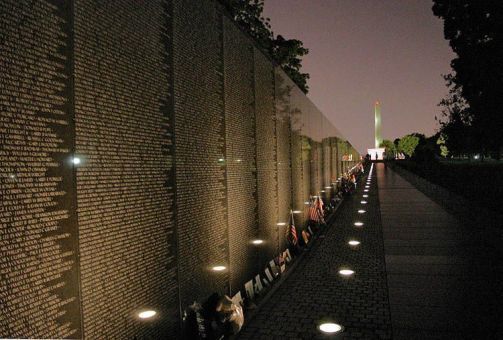
Many of us were unable to cope with it, were not able to get through it, and return to anything like a normal life. Thousands of Vietnam veterans ended their own lives rather than live with the memory of it. Others tried whatever they could to forget – alcohol and drugs usually, but in the long run that only messed them up worse. Still, others simply went insane and parted ways with reality. War in many ways is the “gift” that keeps on giving. It continues to claim victims years after the bullets have stopped flying and the bombs have stopped dropping. Many men die in war but don’t drop until years later. They are not remembered or honored on monuments, not mentioned in Memorial Day speeches, but they are war casualties nonetheless – the same as if they’d gotten a bullet through the head.
The hell that was served to the youth of my generation was that we were brought up in the era shortly after World War II. Our country was basking in the glory of a war well fought and won. A war fought with rectitude, for righteous reasons. We were weaned on John Wayne and Audie Murphy movies, given a glossed-over history of our country in school (and on television), and were totally convinced that we Americans were always the good guys and our government leaders were patriots and therefore would never lie to us. Vietnam made us question all that. We began to rethink everything we learned when we were growing up and in my case anyway, it was bitterly heartbreaking. I, like the majority of Vietnam Vets, was a volunteer. There were other reasons why I joined the army, but one of the main ones was to serve my country. Then I discovered my country wasn’t what I thought it was.
That our leaders would send us into an unwinnable war without a viable exit strategy and without any (or damn little) indoctrination as to why we were being sent I feel was part of the reason we lost. We weren’t motivated. We were simply told that communism was bad and we had to draw the line in Vietnam, domino theory, all of Asia would fall, etc., etc. Turns out the domino theory was dead wrong – after the war, Vietnam went into Cambodia, overthrew Pol Pot’s murderous, communist regime, and reinstalled the monarchy, which is to this day still in power – the exact opposite of the domino theory doctrine.
Regardless of what you thought about the Vietnam War, the fact is that 2,709,918 Americans served in Vietnam, representing almost 10% of their (very large) generation. 40% to 60% of those were either in combat, provided close support, or were regularly exposed to enemy attack. 58,318 names of American men and women who died in the war are etched on the black granite slabs of the Vietnam Veterans Memorial in Washington D.C. 11,465 of those on the wall were not yet 20 years old, still teenagers – 5 of them were just 16 years old. Kids.
It is fitting and important on this Memorial Day, that we take time out from our burgers and beer to remember the people who gave their lives for this country. To remember their deaths in all its raw ugliness. Remember that for every name on the wall, there was a family back home – wives, girlfriends, children, and friends affected by their death. Remember that it could have been you or someone in your family. Remember that our leaders sent tens of thousands of young men and women to their deaths in the prime of their lives. To remember that it can and will happen again – indeed, still is happening. Remember that unless we put an end to war, it will surely put an end to us all.
Put yourself in their place.
From the author:
I spent a year and a day in Vietnam with the U.S. Army’s 1st Cavalry Division. I was in Charlie Company, 1st Batallion, 12th Cavalry Regiment (Airborne), from May 1966 to May 1967. Our base camp, Camp Radcliff was in the central highlands of Vietnam outside the small farming village of An Khe (now a town of over 50,000). We were on field operations almost continuously during the year I was there, with only a few short breaks. Our operations were in the provinces of the central coast and the central highlands. Of all the firefights and skirmishes I was in, this night a LZ Bird was the most intense and the most horrifying. I was 19 years old at the time and it has colored my entire adult life since. When I saw the inhumanity, brutality and ugliness of war up close, it turned me into a lifelong pacifist. I realized that though there are things worth fighting for, most of our wars are based on lies and started for reasons and ideas that are just plain wrong. If the human race is to survive, we need to find a way to get along together, or we’re all going to die together.
Here is the direct link to the article: https://warstoriesweb.wordpress.com/
*****
Admin: Readers, can you add to Spencer’s analogy?
Thank you for taking the time to read this. Should you have a question or comment about this article, then scroll down to the comment section below to leave your response.
If you want to learn more about the Vietnam War and its Warriors, then subscribe to this blog and get notified by email or your feed reader every time a new story, picture, video and changes occur on this website – the button is located at the top right of this page.
I’ve also created a poll to help identify my website audience – before leaving, can you please click HERE and choose the one item that best describes you. Thank you in advance!
December 15, 2023
End of the Year Book Sale
I’m excited to announce that my e-books will be promoted on @Smashwords as part of their End of Year Sale from December 15th until the 31st! My 3-short stories are FREE and my 3-Vietnam War books are reduced by 50%. Don’t miss out on this opportunity. https://www.smashwords.com/profile/view/jpodlaski

December 9, 2023
A Chunk of My Life Was Taken From Me. You Could Say I Had a Bad Attitude.
After completing our tours in Vietnam, many of us still had stateside duty assignments of a year or less to complete before ETS. Some had a difficult time “fitting in” with the pomp and formality of stateside military duty. Others struggled but complied. Some jobs were great, others not so much. Here’s what one man ‘fell into’ and ended up loving it.
by Ed Meagher
When I returned from Vietnam in February of 1969 I had a bad attitude—a very bad attitude.
I joined the Air Force to escape college and a broken heart (another story entirely). It turned out that the discipline, order, and focus the Air Force provided was exactly what I needed, and for the first 18 months, I thrived.
My first duty station was an aircraft control and warning site on the northwest coast of the island of Luzon in the Philippines—100 airmen and contractors on a cliff above the South China Sea. Though there was nothing to complain about, we did manage to grouse about the isolation.
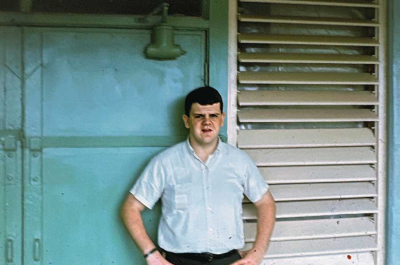
Ed Meagher in the Philippines in 1967. Photo courtesy of the author.
I found books and started a library (yet another story entirely). A mentor guided my reading, and I used the endless hours to devour books of every sort. The work I did was challenging and rewarding, and then I got to read sitting in a chair overlooking the South China Sea. I remember the feeling to this day—I was a kid who fell into a vat of chocolate and got to swim in it.
After seven months I transferred to Clark Air Base in Southern Luzon north of Manila. Despite tens of thousands of airmen and contractors and a far more hectic work schedule, I still found a quiet place to fall into books.
As I neared the end of my tour in the Philippines, I chose to go to Vietnam. To this day I have a difficult time talking about my time there. I was unprepared for the enormous responsibilities thrust upon me. The stakes were high, as high as they get. I wish I could have done better, been better. But I know I did the best I could at the time.
Still, I was different when I arrived at the Pentagon in 1969, and so was the world. Three years earlier, the radio had played Peter, Paul, and Mary, and hootenannies were still in fashion. Now, Grateful Dead and the Rolling Stones blared from boom boxes, and it seemed like everyone had just returned from Woodstock.
Meanwhile, I’d spent a year in fear of death or dismemberment. I couldn’t lower my perception of the threat level around me, and I couldn’t explain my feelings to anyone. Everything felt trivial, everyone around me out of touch with reality.
Military life stateside was also far different than military life overseas where the attitude was, “Do your job, stay out of trouble, and don’t be a slob.” We’d been too busy with real military operations to tolerate “chickenshit.” It seemed to me my Pentagon assignment was built solely on unadulterated chickenshit.
It started my first day on the job after a month at home. I’d spent two and a half years in fatigues or flight utility uniforms, and no one cared how they looked on me or anyone else. Now I reported to duty in my dress uniform for the first time since it was issued in basic training. It was a little ragged—no name tag or ribbon rack, and my sister may not have sewn on my new rank correctly. I couldn’t find my dress shoes, so I wore my jungle boots. I also needed a haircut.
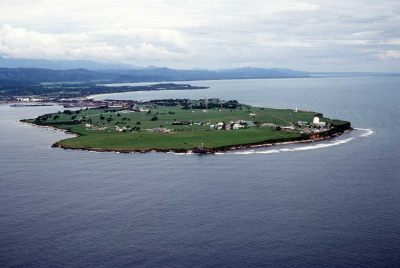
Ed Meagher loved the first 18 months of his Air Force career at Wallace Air Station on the island of Luzon in the Philippines, now Naval Station Ernesto Ogbinar. From there, Meagher headed to Vietnam. By the time he arrived at the Pentagon in 1969, he had resolved to leave the Air Force. Photo courtesy of the author.
Most importantly, I didn’t want to be there. A month’s vacation convinced me I was done with the Air Force. A huge chunk of my life had been taken from me. I’d missed all the major milestones of my generation. In general, as I believe I mentioned, I had a bad attitude.
As I walked across the massive concourse in the Pentagon, I felt like a polar bear at a beach resort. I noticed several glances and double-takes. Then I saw a newly minted second lieutenant walking directly toward me. I tried to angle away from him, but he was coming for me. He stopped me with a sharp “Sergeant” that I couldn’t ignore, then asked my name.
I answered without using “sir” or “lieutenant,” and he called me on it. He told me I was out of uniform, and I agreed with him. He waited for an explanation, and when I didn’t give him one, he asked. Point in my favor. After I explained, he told me that was no excuse. I told him he was making me late for a meeting with my new commanding officer, wished him a good day, and walked away. I believe I may have mentioned that I had a bad attitude.
It didn’t go a lot better when I reported in. I met with a first lieutenant who may or may not have been my boss. He was about to dismiss me for the day when the squadron chief master sergeant burst into the office in a fit. He’d heard about me, and he very insincerely apologized to the lieutenant for my appearance, for my imposition on his valuable time, and for my very existence. He saluted the lieutenant, then turned and growled at me, “In my office, Sergeant, now.”
The rest of the day didn’t go a lot better. As the chief ranted and raved over my hair and jungle boots, I struggled not to laugh. I’d been in the culture long enough to know to agree with whatever he said and say as little as possible in response.
I had 12 months left in my military career, and I didn’t know how I would survive it. That’s when one of my many undeserved good karma gifts arrived in the form of Hap Arnold.
I’d come to the Pentagon with a recommendation attached to my personnel record that the Air Force retain me. The service had spent a lot of money on my training, and I’d performed well for three years. As a result, I was assigned a retention counselor to convince me to reenlist for another four years. Hap was a retired Air Force chief master sergeant-turned-GS-11 Air Force civilian.
We hit it off when I noticed a Chicago Cubs banner in his office that said, “We’ll win the World Series next year.” We spent the first 15 minutes talking baseball. When we got down to business, I told him there was no way I was going to reenlist. He asked why and I vented for several minutes.
He listened quietly, then said, “Wow, I’m sorry to hear all that. How can I help?”
I told him how the Air Force had denied an off-base housing allotment, and that all my uniforms and baggage from Vietnam had been lost. Hap arranged for me to receive both the housing allotment and a uniform allotment. My biggest problem, though, was my assignment. I’d received a demeaning job with the worst possible schedule. He told me that might take a little while to fix, but he’d work on it as long as I lightened up on my bad attitude. We shook on it, and believe it or not, that is really the story I started out to tell.
A couple of weeks later I got a message to report to Hap’s office. We chatted for a few minutes, but it was clear from the look on his face that he had some good news for me. He had called in a favor; I was transferring to the Military District of Washington Command Post. That alone was an answered prayer, but Hap had more.
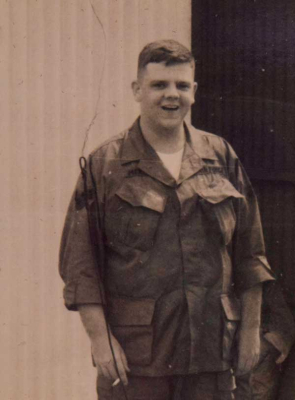
As Ed Meagher neared the end of his tour in the Philippines, he chose to go to Vietnam. To this day, he has a difficult time talking about that life-changing experience. Photo courtesy of the author.
He had gotten me assigned as the duty noncommissioned officer in charge of the entire Military District of Washington each weekend. It was an insignificant trash job that no one in their right mind would want, but he knew I would love it and I did. I worked 12-hour shifts Friday, Saturday, and Sunday nights from six p.m. to six a.m. No formations, no inspections, and no harassment. Just, “Do your job, stay out of trouble, and don’t look like a slob.” The transfer was immediate. When I reported for duty, I was most definitely “STRAC”—military slang for “a well-organized, well-turned-out warrior,” including a “high and tight” haircut.
The Military District of Washington is an artifact of the Civil War, formed to protect the capital. While it still serves that role, its duties are mostly ceremonial now. Most importantly, and for the purpose of this story, any active-duty service members who are not under orders from their command and find themselves in the Military District of Washington also find themselves under its command. I served as the single point of contact for any problems that arose during the weekend or for any active-duty servicemember who wandered into the Military District of Washington. And they did wander in, for several reasons, including to frequent one of the dozens of after-hour night clubs in the southwest quadrant of Washington where “blue laws” were unofficially relaxed.
Everything about these clubs was conveyed by word of mouth. Some were known for their music or dance bands, others for their class and decor. All were known for their booze, and many were known as strip clubs, or “titty bars.” These places attracted the most military personnel who came to the Military District of Washington.
My job was simple. By six p.m. on Fridays, we settled into a trailer with four phone lines. One was an open line to the command center. Another was a direct line to the military police office at Fort McNair in southeast D.C. The third was a line to the Metropolitan Police District Six front desk. The fourth line was the most interesting. It was a regular D.C. phone number that was very quietly given to the owners, bartenders, and bouncers of these illegal-but-tolerated after-hour clubs with the understanding that they’d call it for a resolution if there was ever an issue with a G.I.

An alley in the southwest quadrant of Washington, D.C., in 1970, where “blue laws” were unofficially relaxed. Service members frequented the bars, nightclubs, and strip clubs here—and from time to time got into trouble. That’s when Ed Meagher, the duty noncommissioned officer in charge of the entire Military District of Washington each weekend, was called. Photo courtesy of the author.
The first calls came in around 10 p.m. Every call was unique, but in truth, they were the same: Pfc. or Sgt. or Lt. So and So had gone to a club, had several drinks, engaged in conversation with a lovely young lady, bought the young lady several glasses of champagne, and then suggested they continue the evening in a less public place. Often at this point, the lovely young lady would lose interest and head backstage, and the soldier, sailor, airman, or Marine would receive a bill that approached their monthly pay. Harsh words were exchanged, followed by various forms of martial arts. While these warriors displayed some courage and even skill, it always resulted in them being handcuffed to a wall in a closet or storage room in the back of a club, where inevitably this mysterious phone number was written on the wall.
That’s where I came in.
Two large, newly minted, temporary military police officers and I would head to this location. We first checked on the physical condition of our combatants. Most bouncers stopped short of great harm for fear of sending them to a hospital, and the ensuing, inevitable questions. If their injuries did not appear life-threatening, we moved on to the next phase. This involved collecting all the money the G.I. had in his possession.
I required them to turn their pockets inside out and take off their shoes and socks. I took the money, met the bar owner or manager, and offered whatever it was to settle their bills. There was no real negotiation; either they took it or I’d call the cops and let them sort it out. Since involving the police was a nonstarter, the negotiations ended, and we moved on to phase three—often the most difficult.
Dealing with still-drunk combatants who often outranked me and wanted a second round with the bouncer was never easy. Before I had them released from the club’s bracelets, I told them their best option was to go quietly back to our trailers to sort out this injustice. Most did, after some heated discussion, but every once in a while, I needed the muscle provided by our two young and eager military police officers.
Once back at the trailer, we sorted them into a holding cell, a cot, or a vomitorium in the back. At about five a.m. we woke them, and I told them I was just the greatest guy in the whole world and they could return to their units without any record of their indiscretions, or I could drive them in handcuffs to the stockade at Fort Myer to deal with the full force of the military justice system. Only one to my memory, a young Marine lieutenant, chose the second option.
This detail saved my military career. It filled all my needs at that point in my life. Strange as it may sound, I found it rewarding, and most importantly it got me over my bad attitude.
Admin: How did you fare after your tour of duty in Vietnam?
 Ed Meagher
Ed MeagherEdward Meagher is a Vietnam service-disabled veteran who retired after 24 years in government, 26 years in the private sector, and four years in the U.S. Air Force. He served for seven years as the deputy assistant secretary and deputy CIO at the Department of Veterans Affairs. He lives in Great Falls, Virginia.
*****
This article originally appeared on THE WARHORSE website on May 3, 2023. Here is the link: https://thewarhorse.org/air-force-veteran-recalls-washington-detail-that-saved-him/
Thank you for taking the time to read this. Should you have a question or comment about this article, then scroll down to the comment section below to leave your response.
If you want to learn more about the Vietnam War and its Warriors, then subscribe to this blog and get notified by email or your feed reader every time a new story, picture, video and changes occur on this website – the button is located at the top right of this page.
I’ve also created a poll to help identify my website audience – before leaving, can you please click HERE and choose the one item that best describes you. Thank you in advance!
December 2, 2023
MY LAST ’NAM FLIGHT
photo courtesy of CHRISTOPHER GAYNOR
One soldier recounts his flight home from Vietnam. How many of you had a similar experience?
By Douglas Crow, retired
We were given a ride in the Jeep on the morning of April 5th, 1970 to Phouc Vinh Airport and we waited four hours to catch a flight to Bien Hoa.
While boarding the De Havilland C-4 Caribou, its engines idled with a low coughing moan. I took a seat while looking out the opposite window and saw a Navajo Cavalryman sitting there in the hot noon sun. Silently and without motion or seeming emotion he sat passively.
As the engines idled, I watched the shadow of the rotating propeller blades being cast on the runway. The crew chief, sweaty as usual and carrying a revolver slung low on his hip, brought the boarding plank up into the aircraft’s belly and with a loud whirring sound of a servo motor brought up the aft door. The chief mumbled something in his headset, walked to the front of the craft just behind the cockpit cabin entrance, strapped himself in and fiddled with a circular slide-rule in conjunction with a map.
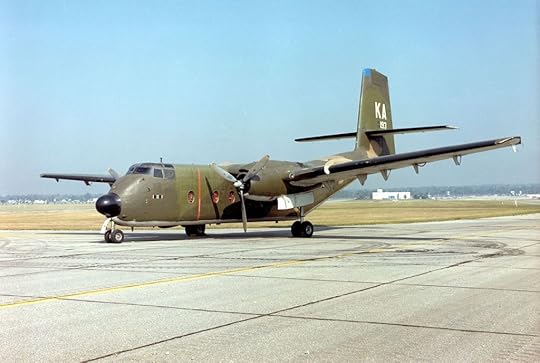
The pilot looked all around for visual clearance then slowly moved the throttles forward and as I looked out the circular port windows, I could no longer discern the shadows of the propeller blades but only a faint, grey oval optical shadow. The engines coughed a little but rallied and slapped the air with determination. The pregnant bird began to move and a vibration growled and grated throughout the fuselage as the bird’s wheels rolled faster and faster over the corrugated, olive drab-painted, steel runway. The grass on the airfield was tan and dead. As the Caribou taxied down the ramp I thought about the Navajo Cavalryman and it suddenly dawned on me that any time I left a place or arrived someplace in Vietnam, I had always seen at least one American Indian in jungle fatigues.
It’s funny that I should have realized that so late in the year, but as I thought back over the times of traveling through in-country airports; the three-day R&R to Vung Tau, the Hawaii R&R, the battalion moves to and from Tay Ninh and Phouc Vinh, I suddenly recalled meeting, talking with, or seeing American Indians at practically all those locations and that seemed unusual to me.
The Caribou swung around at the end of the runway, its brakes squealing as it came to a stop. After checking an operations list and conversing over a microphone, the pilot thrust the throttles fully forward for the takeoff. The craft sat there lurching for a minute, straining all its power against the brakes, wings shifting back and forth. Watching all the loose rivets bob and bounce as the craft trembled with a tooth-tingling vibration made me question whether the rivets were attended to during the craft’s overhaul maintenance.
At last the brake was released and everyone in their side-by-side, single-line, orange polyester web seats seemed to be thrown almost on top of each other from force suddenly thrust upon us by the bird’s takeoff momentum. The aircraft seemed to struggle to get off the ground, like some frightened, waterfowl that had just been shot at. It rolled and rolled over the runway picking up more speed and with both engines thrumming with maximum power, the flight finally became airborne.
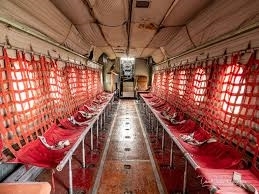
The Caribou is an over-wing aircraft and its round, port-like, windows are beneath the wings. The portion of the red nylon webbing bench I occupied happened to be positioned at the point where the wings joined the fuselage which gave me a full view out the port window, rendering the underside portion of the engine nacelle fully visible to me. We must have now been at an altitude of about 1500 feet or so and as we heard a servo motor groaning somewhere in the wings, the still-spinning wheels retracted themselves up through and into the bottom of the engine nacelles with the landing gear doors closing shut immediately thereafter.
At last, Phouc Vinh was behind and below us. Looking back, we could see the JAG and PIO buildings which seemed not all that far from the edge of the Camp Gorvad perimeter green-line bunkers and tower fortifications facing the vast rubber plantation stretching outwards toward a hazy horizon.
After an uneventful, short flight we were now in the approach landing pattern at Bien Hoa Airfield and in just 15 short minutes the Caribou’s wheels touched down on the airport’s runway with a barely audible and lightly felt screeching sound. As the aircraft rumbled up the ramp toward the terminal, the crew chief hurriedly unstrapped himself, hopscotched aft, and opened the rear exit ramp door. The door lowered with a slow but constant hydraulic moan as the horizon shimmered through the mirage-like heat rising from the runway. The craft slowed as the pilot cut the engines, and the prop blades swung ever slower until the sound of the engine’s valve lifters became discernible.
A procession of red-soiled, soldiers clad in jungle fatigues emerged through the Caribou’s aft ramp bay. Their postures were thrust forward because of their weighty packs as they set one foot in-front-of-the-other. Fixed eyes stared intently from beneath the heavy steel helmets and a PRC-25 radio antenna swung absurdly as an RTO (Radio Telephone Operator) made his way to the terminal. Finally, they were all lost to the throng milling about inside Bien Hoa terminal.
I must’ve sat at that terminal for an hour or so waiting for a bus to be transported to the Cavalry’s R&R DEROS Center. I finally boarded a bus, but got tangled up in misunderstood semantics and ended up in Long Binh for another hour or so before finally catching a bus ride and arriving at the R&R DEROS Center just before curfew. From then until late last night when boarding the “freedom bird,” my perceptions were a timeless blur of sleepless, hypnotic waiting.
THE FREEDOM BIRD
My entire military Vietnam out-processing phase had been blessed with artillery silence. There were tales I had heard from other soldiers about returnees being killed by enemy 122 rockets while they were waiting for or boarding their freedom birds, but I really didn’t know whether these stories were true or not. Admittedly, the fear those tales may have been true hung over me like an axe all year. Indeed, I think that’s probably why I never was really overwhelmed by “short timer’s fever” or never felt “short.”

At long last, we boarded the 707 passenger liner in our jungle fatigues and I broke out in a cold sweat as the bird whistled down the runway. Finally, the great silver bird roared off the runway and ascended to an altitude far out-of-range of enemy .51-caliber enemy guns or rockets in no time at all!
But nothing happened, thank God, and the whole planeload of GIs cheered and screamed uncontrollably as the craft flew over the Vietnam Coastline out toward the Pacific and homeward. I have really never had such a feeling of total relief and freedom in my life as I had during that departure. To really know that at last, the threat of some rocket with my name on it was once-and-for-all extinguished at that country’s shoreline was unforgettable. The lifting of that burden puts a whole new fresh breath into one’s life! WOW, just plain WOOOWW!
BACK IN “THE WORLD”
By 1982, after the end of my stateside military service at Fort Riley, Kansas, employment difficulties, marriage tensions, the ambient anti-war sentiments, and a general cultural dislike of anything military, it became apparent to me that I was having just way too many close-call, near-misses, and narrow escapes. In analyzing these incidents, it became shockingly clear that there was something of a self-destructive dynamic occurring within my being. And that I was engaging in subconscious attempts to end my life!

Despite my analysis, just the fact that I was apparently being controlled by a “death wish” was an overwhelming shock. It was as if there was some indiscernible, subconscious, hunter-killer submarine pursuing me. All I knew was that I had to quickly discover the source of this threat before it sent me to the deep six. Becoming conscious of my apparent classic case of “survivors’ guilt” substantially unnerved me and I knew I had to overcome it in short order before it overcame me.
Upon that realization, I immediately sought help from my family, mental health professionals in the private sector, the Veterans Administration, and Vet Center Counselors where I lived.
It heartens me to report that if it were not for my Creator, Family, Country and the VA in particular, I am certain, retrospectively, that I would have become yet another non-KIA statistic of that war. I credit my Maker, beloved father and mother together with the Veterans Administration for my recovery from that deadly, tumultuous interval. If it were not for these blessed positive elements available to me, I am convinced my physical and mental welfare would have been severely denigrated if not annihilated.
Douglas Crow had an earlier post published on my website titled “Close Calls”. You can find it here: https://cherrieswriter.com/2020/09/20/close-ones-during-the-vietnam-war/
*****
Thank you for taking the time to read this. Should you have a question or comment about this article, then scroll down to the comment section below to leave your response.
If you want to learn more about the Vietnam War and its Warriors, then subscribe to this blog and get notified by email or your feed reader every time a new story, picture, video or change occurs on this website – the button is located at the top right of this page.
I’ve also created a poll to help identify my website audience – before leaving, can you please click HERE and choose the one item that best describes you. Thank you in advance!
November 25, 2023
A Memory I Can’t Forget
The author recreates an experience he had while serving in Vietnam. He was awestruck and helpless at the time. It is something he will never forget.
December 1967 at a bridge south of Phu Bai. We were building a creosote timber bridge to replace one that had been blown up by the VC. It was about 75 yards across the river and the Army Engineers had installed a temporary flotation bridge just below the bridge we were building. The traffic up and down Highway 1 would go down a ramp and slowly cross the bridge.
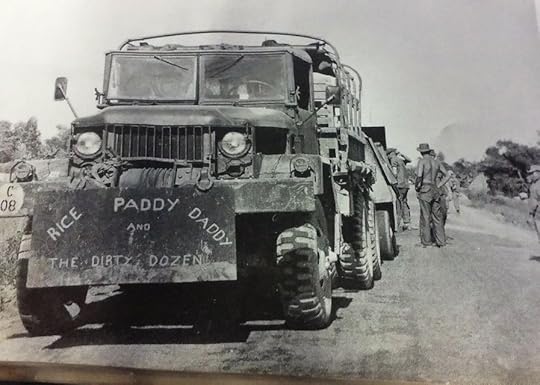
On top of the bridge where we worked, we were about 15 feet higher than the flotation bridge. About 100 feet upstream from where we worked an old rusty steel bridge still carried trains across the river. A little village was right there on both sides of highway one immediately north of the bridge. It wasn’t very large but approximately 100 villagers lived there. A platoon of South Vietnam Soldiers were also stationed nearby to protect the village and bridge.
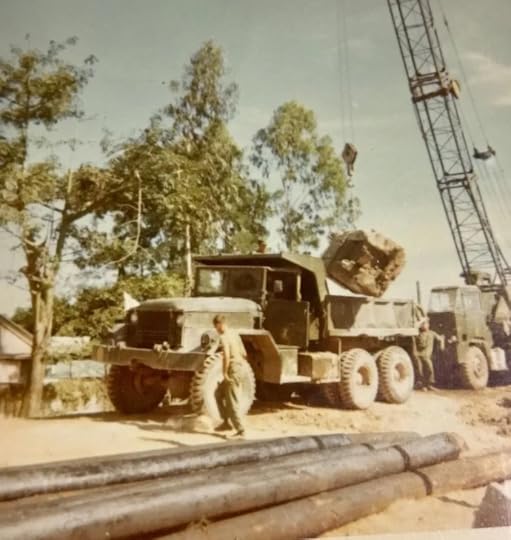
I was on top of the bridge nailing decking on a section of the bridge when late in the afternoon, my Squad Leader told me to go into the village and see if I could purchase some cold drinks. I grabbed my web belt and buckled it and picked up my M-16 rifle.
Sometimes we were able to buy cold drinks in the village, they had a drink they claimed was Coca Cola but it didn’t taste much like it. It usually was flat tasting.
I walked into the village I had slung my rifle over my shoulder by the sling. I got to the old lady’s house that sold the cokes and she met me at the entrance. The house was small and had cardboard boxes flattened out and tacked on the outside. The roof was thatched with big leaves and they hung over by about a foot.
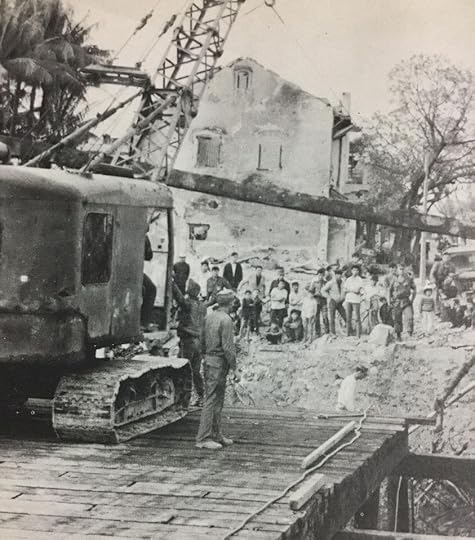
She inclined her head to me and then looked up and asked what I needed. I told her cold drinks and she said, “Aaah,“ and turned, disappearing back inside her house. She came back out with a canvas bag filled with cool drinks. I smiled and asked her how much I owed her. She told me and I gave her a 500 piaster note. A big grin split her face before she grabbed the money; her teeth were bright red. I thanked her and turned to leave and headed back to the river.
Suddenly I saw a half dozen Vietnamese soldiers emerge from between two huts. They were dragging a young Vietnamese boy between two of them while the others followed behind. I stood and watched them heading toward the river dragging this boy. He was terrified. Screaming and crying, and tried unsuccessfully to dig his heels in as they continued toward the river, the soldiers were stronger. They were all talking in Vietnamese and I couldn’t understand what they were saying. Curious, I followed closely behind.
As we neared the old railroad bridge the young boy tried to jerk away from his captors. One of them backhanded him savagely and the boy sagged between them. I didn’t like the way this was going. Some of the villagers had also gathered and stood back about twenty feet, most were crying and wringing their hands. One of them screamed at the boy’s captors, who then screamed back, silencing the group.
As I stood off to the side, I set the filled Coke bag down on the ground, slipped my weapon off my shoulder and raised it toward a firing position. One of the Vietnamese soldiers saw me, then quickly raised his own weapon and aimed it at me. He looked at me and shook his head, saying, “No No.“ He then switched his M-1 Carbine from safe to fire and waited to see what I’d do next.
Stunned, I reslung my weapon onto my shoulder and stood there watching in awe. An ARVN soldier brought a rope and tied it around the boy who groaned and began waking up. Two of them yanked him from the ground and carried the boy up onto the railroad bridge. They marched about twenty yards from shore and lowered him over the side, tying the rope so he was suspended just above the water.
He came to again and began crying and screaming, his body moved about frantically in attempts to free himself. The two Soldiers left the bridge and came down to join the others. Without a word, they lined up as a firing squad and prepared to fire at him.
I was now guarded by two of them. One pointed to the boy and said,” VC”. I shook my head in rebuttal and looked down to the ground. Suddenly, one of the soldiers fired and hit the boy in the leg. Seconds later, a multitude of shots followed. The screaming came in spurts and then became silent. I walked away as they reloaded. The ARVN soldiers continued to fire at his extremities until they were gone.
I was sick after watching them execute the young boy. As I neared the creosote bridge, I went behind a stack of boards and threw up, heaving until I could no more. When I looked back up towards the railroad bridge, I saw the body hanging there, only a torso swinging in the wind. The ARVN soldiers walked away celebrating.
For days I was sick over this and kept telling myself there was nothing I could have done to prevent this tragedy. And to this day, I can not get this experience out of my head. Just another day in Vietnam.
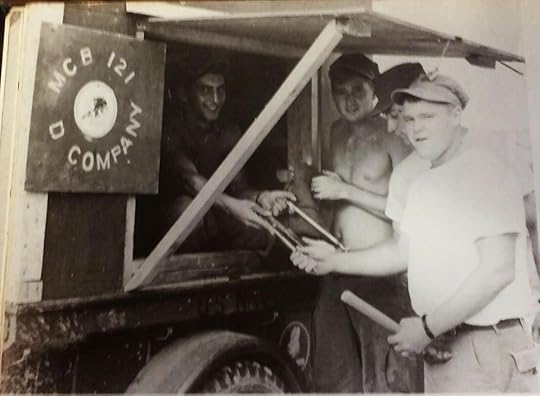
This article originally appeared on my Facebook Group page: I-Corps, Viet Nam June 28, 2019. If you are a Nam Vet and served in I-Corps, then consider joining this group.
*****
Thank you for taking the time to read this. Should you have a question or comment about this article, then scroll down to the comment section below to leave your response.
If you want to learn more about the Vietnam War and its Warriors, then subscribe to this blog and get notified by email or your feed reader every time a new story, picture, video and changes occur on this website – the button is located at the top right of this page.
I’ve also created a poll to help identify my website audience – before leaving, can you please click HERE and choose the one item that best describes you. Thank you in advance!
November 18, 2023
AS US TROOPS WITHDREW FROM VIETNAM IN 1972, THIS CITY REFUSED TO SURRENDER TO COMMUNIST INVADERS
 Three U.S. advisers seek protection from incoming North Vietnamese artillery on April 3, 1972. The communist assault on the South, dubbed the Easter Offensive, triggered intense fighting in and around the town of An Loc, just 60 miles north of Saigon, inspiring acts of sacrifice and heroism among both South Vietnamese and American defenders. (AP photo)
Three U.S. advisers seek protection from incoming North Vietnamese artillery on April 3, 1972. The communist assault on the South, dubbed the Easter Offensive, triggered intense fighting in and around the town of An Loc, just 60 miles north of Saigon, inspiring acts of sacrifice and heroism among both South Vietnamese and American defenders. (AP photo)
During the Easter Offensive of 1972, these American advisers gave their all to save An Loc and prevent the fall of Saigon and ultimately South Vietnam.
Easter came early in 1972 and the North Vietnamese Army (NVA) came with it. On March 30, “Holy Thursday,” three NVA divisions stormed out of Laos and across the DMZ. It was the first of multiple assaults that struck not only the northern provinces of South Vietnam but also Kontum in the Central Highlands and An Loc, only 60 miles north of Saigon.
North Vietnam was “going for broke,” committing its entire combat capability—14 divisions and 26 separate regiments, all with attached armor and heavy artillery units. Enemy forces numbered 130,000 troops and 1,200 tracked vehicles, primarily tanks. Aging Communist revolutionaries controlling Hanoi’s Politburo believed the time was right to achieve a decisive military victory, topple South Vietnam’s government, and embarrass the United States.
As U.S. military personnel continued to withdraw, American troop strength was brought down to 69,000. Only two U.S. combat brigades remained—their missions were restricted to guarding airbases and patrolling the surrounding areas. Although the Military Assistance Command, Vietnam (MACV) listed 5,300 men as “advisers,” the only Americans fighting on the ground were a handful of men serving with provincial advisory teams and Army of the Republic of Vietnam (ARVN) divisions and regiments.
As a result of Vietnamization, battalion advisers were only authorized in the Airborne Division, Marine Division, and selected Ranger units. There were also battalion advisers, mainly NCOs, with the ARVN field artillery battalions.
AMERICANS ON THE FRONT LINESThe term “adviser” was a misnomer. By 1972, advice was rarely solicited and when offered, rarely heeded. However, U.S. advisers often cajoled and encouraged their counterparts, particularly in dire situations when spirits were flagging. The presence of even a lone American adviser was a morale booster, as every ARVN soldier knew they would not be abandoned as long as one American was with them.
The advisers’ primary role was employing the massive air assets President Richard M. Nixon had sent to South Vietnam. U.S. air power proved decisive in blunting the 1972 enemy offensive. Advisers routinely exposed themselves to NVA fire while working with USAF forward air controllers, identifying lucrative targets and adjusting air strikes to ensure bombs were “on target.”
Americans who remained on the front lines, especially advisers with airborne and Marine battalions, suffered significant casualties. Adm. Chester Nimitz’s famous quote after World War II’s Battle of Iwo Jima in 1945 was equally applicable to the advisers who helped turn back the NVA offensive 27 years later: “Uncommon valor was a common virtue.”
Early in 1972, allied intelligence personnel were watching NVA build-ups in Laos and Cambodia but had no idea of the timing of a possible offensive. When it occurred, the ARVN Joint General Staff (JGS) and MACV were surprised by its scale and ferocity. With fighting raging in three areas, military officials were unable to determine the communist main attack. The focus of III Corps, the ARVN headquarters responsible for provinces surrounding Saigon, was on enemy attacks in Tay Ninh. These were diversionary operations, masking the movement of three NVA units: 5th VC Division, 9th VC Division, and 7th NVA Division. The 5th and 9th were VC in name only; they were manned and equipped by the North Vietnamese Army.
The situation grew more tenuous on April 5, 1972, when those divisions—36,000 troops organized into combined arms teams of infantry, armor, heavy artillery, and engineers—poured across the Cambodian border into Binh Long Province. The immediate threat to the government in Saigon was clear.
 South Vietnamese paratroopers march north along National Route 13 (QL 13), the main road from Saigon, on April 8, 1972. The troops are heading to the provincial capital of An Loc to try to counter the gains made by the communists when they poured over the Cambodian border a few days earlier. (AP Photo)
South Vietnamese paratroopers march north along National Route 13 (QL 13), the main road from Saigon, on April 8, 1972. The troops are heading to the provincial capital of An Loc to try to counter the gains made by the communists when they poured over the Cambodian border a few days earlier. (AP Photo)
Maj. Gen. James F. Hollingsworth, commander of the Third Regional Assistance Command (TRAC), urged Gen. Nguyen Van Minh, III Corps commander, to reinforce An Loc, the provincial capital. Hollingsworth, a 1940 graduate of Texas A&M University, was one of Gen. George S. Patton’s outstanding tank commanders during World War II. He led from the front and during his service in three wars he was awarded three Distinguished Service Crosses (DSC), the nation’s second highest award for valor, four Silver Stars and six Purple Hearts, plus four Distinguished Service Medals and 38 Air Medals.
Known as “Holly,” he was also a Korean War veteran and had served a previous Vietnam tour as assistant division commander of the famed 1st Infantry Division. Advisers revered him and were grateful for the air support he was able to muster.
A CITY UNDER SIEGEThe district town of Loc Ninh, a few miles from the Cambodian border, fell on April 7 when the NVA overran it, killing or capturing nearly 1,000 soldiers. Two U.S. advisers were killed and seven were listed as missing in action. Only 100 ARVN defenders and one American, Maj. Tom Davidson, managed to escape the battle and make their way to An Loc, which was 15 miles south and obviously the enemy’s next target. The 5th ARVN Division defended An Loc with three infantry regiments, two ranger battalions, and provincial forces.
 James F. Hollingsworth. (Bettmann/Getty Images)
James F. Hollingsworth. (Bettmann/Getty Images)
If An Loc was lost, there were no ARVN troops to stop an enemy move on Saigon. President Nguyen Van Thieu issued a directive that An Loc must be held at all costs. The well-publicized order caught the attention of the communists, challenging them to quickly capture it. The pivotal battle for An Loc and the heroism of U.S. advisers there was a microcosm of the fighting throughout South Vietnam in what the U.S. press now called the Easter Offensive.
On April 7, 1972, President Thieu convened a meeting of his key advisers and corps commanders to assess the military situation; it was a grim session. General Minh outlined his circumstances and requested more troops to reinforce An Loc, surrounded by the 5th and 9th VC Divisions. He also pointed out the 7th NVA Division had cut the main supply route, QL (National Route) 13, into the provincial capital, isolating the defenders.
Because of the enemy’s proximity to Saigon, the president made the unprecedented decision to commit the country’s last reserve, the 1st Airborne Brigade, to III Corps. He also directed the 21st ARVN Division move from the relatively quiet Mekong Delta region and join the battle in Binh Long Province.
By the afternoon of April 8, the 1st Airborne Brigade, augmented by the 81st Airborne Ranger Battalion, was assembled south of An Loc, ready to fight. The 81st was originally activated as a reaction force during the days of cross-border operations into Cambodia, Laos, and North Vietnam. Now, it was employed as an elite infantry battalion. It was teamed with the Airborne Division because its advisers were part of the Airborne Division Assistance Team, also designated MACV Team 162. The brigade’s 2,000-plus paratroopers were tasked to open QL 13 into An Loc. Soldiers of the 7th NVA Division, 8,600 strong, had prepared extensive defensive fortifications along the vital supply route. The NVA easily stopped the 1st Brigade.
A ONE-MAN OPERATIONWith a stalemate occurring, Hollingsworth recommended a mission change: reinforce An Loc with the 1st Airborne Brigade and have the 21st ARVN Division clear QL 13. The paratroopers were needed because on April 13 the NVA kicked off an armor and infantry attack that threatened the town.
Late in the afternoon of April 14, the 6th Airborne Battalion, about 400 paratroopers, conducted a helicopter assault into an LZ near key terrain just south of An Loc. Two American advisers, Maj. Richard J. Morgan and 1st Lt. Ross S. Kelly, accompanied the battalion commander, Lt. Col. Nguyen Van Dinh, in the first lift. The high ground, Hill 169 and an adjacent feature called Windy Hill, was needed for an artillery firebase. It would provide support for the 5th ARVN Division because all its guns had been destroyed by incoming fire.
 South Vietnamese tanks move up Route 13, 40 miles north of Saigon, toward besieged province capital of An Loc,. (AP Photo)
South Vietnamese tanks move up Route 13, 40 miles north of Saigon, toward besieged province capital of An Loc,. (AP Photo)
Initially, the landing was unopposed. Yet the NVA reacted quickly and stopped the paratroopers from gaining the summits of the two hills. The advisers called in air strikes. Kelly, accompanying attacking troops, directed U.S. Army AH-1G Cobra rocket and machine gun fire to within 25 meters of his position, forcing the enemy to withdraw. It was a “danger close” call, but a necessary one.
As the high ground was taken, Morgan, the senior adviser with the battalion commander, suffered a severe leg wound. He needed immediate evacuation or would bleed to death. Fortunately, a U.S. Army Huey helicopter responded to Kelly’s request for a medevac. The pilots braved enemy mortar and artillery fire to rescue Morgan and five ARVN paratroopers who were also seriously wounded.
Kelly, a 1970 graduate of West Point with less than two years in the Army, was now the lone American responsible for the battalion’s desperately needed air support. The old Army expression “operating way above his pay grade” described Kelly’s circumstances.
The remaining battalions, the 5th, 8th, and 81st, plus the brigade headquarters, arrived on April 15-16. CH-47 Chinook helicopters brought in six 105mm howitzers and emplaced them on the high ground, secured by two rifle companies of the 6th Airborne Battalion. Maj. John Peyton, Morgan’s replacement, was in the airlift and joined Kelly on the afternoon of April 16. Peyton was only on the ground two days before he too was badly wounded and evacuated. Again, Kelly was a one-man operation.
 The communists controlled much of An Loc in the early days of the offensive, forcing the South Vietnamese defenders into a small southern sector at the top of this aerial photo. (UPI Photo)
The communists controlled much of An Loc in the early days of the offensive, forcing the South Vietnamese defenders into a small southern sector at the top of this aerial photo. (UPI Photo)
The North Vietnamese commander was not about to allow an ARVN firebase to operate in his area of responsibility. Within 24 hours, NVA artillery fire destroyed all six howitzers and its stockpile of ammunition. The battalions airlifted in on the 15th and 16th were ordered to move into the town and join the 5th ARVN Division defenders who were fending off major NVA attacks. The 6th Airborne Battalion was left on its own. Two NVA regiments with eight tanks began to systematically isolate and destroy the 6th.
Kelly used every air sortie at his disposal to keep the numerically superior foe at bay. The communist commander was determined to annihilate them, regardless of the cost. By April 20, the 6th Battalion had fewer than 150 effective fighters. Seriously injured soldiers died for the lack of medical treatment. U.S. helicopters only flew medevac missions for wounded U.S. advisers—so the evacuation burden fell on the Vietnamese Air Force (VNAF) helicopter pilots, most of whom were sadly lacking fortitude.
WAITING FOR THE NVASupply shortages and the VNAF’s reluctance to fly caused morale to plummet. Having grown used to the robust support from the U.S. Army, the failure of the ARVN and VNAF to perform critically needed tasks was a shock to the paratroopers, including the battalion commander. Lt. Col. Dinh was psychologically overwhelmed and stayed in his foxhole, almost in a trance. Remnants of two rifle companies on the hills, less than 50 men, were forced off and escaped to An Loc. Eighty other paratroopers, who were not on the high ground, formed a tight perimeter and waited for the NVA.
 Route 13 became a battlefield during the assault when U.S. advisers called in B-52 bombers. Here smoke rises from a bomb strike on May 19, 1972, as South Vietnamese troops fought to reach ARVN units and their American advisers farther north. (AP Photo)
Route 13 became a battlefield during the assault when U.S. advisers called in B-52 bombers. Here smoke rises from a bomb strike on May 19, 1972, as South Vietnamese troops fought to reach ARVN units and their American advisers farther north. (AP Photo)
Kelly began to work what little magic he had left. He coordinated with the brigade senior adviser, Lt. Col. Art Taylor, and his deputy, Maj. Jack Todd, for assistance to allow them to break out to the south, away from An Loc. Todd called Kelly at 7:30 p.m. and said three B-52 strikes were scheduled just after dark to hit the concentrations of North Vietnamese threatening the 6th Battalion. U.S. intelligence had a good “fix” on enemy locations. The bombers would drop “danger close,” meaning less than 1,000 meters from the friendlies, the minimum safe distance from B-52 bombs.
Kelly’s cajoling and the news of the upcoming bombing strikes snapped Dinh out of his depressed state. He made the difficult decision to leave the seriously wounded soldiers behind and prepared the men to move. When the first 500-pound bombs began to fall, 80 exhausted men headed to the southeast, away from the enemy. Kelly led while Dinh, farther back in the column, kept the troops moving. The shock of three successive B-52 strikes and rapidity of movement gave the bedraggled force some breathing space.
Throughout the night and into the next day, Kelly continued to serve as “point man” for the small group. On more than one occasion, he called in air strikes on pursuing enemy troops. When Kelly found a suitable pickup zone, the adviser used U.S. air strikes to seal off the area and protect the incoming helicopters.
Finally, VNAF helicopters arrived but they only touched down briefly and several hovered a few feet off the ground, making it impossible for the walking wounded to get aboard. They were not taking any enemy fire. Without warning, they “pulled pitch”—taking off with Kelly hanging on to one UH-1’s struts and leaving 40 soldiers on the ground.
Threats from the battalion commander failed to intimidate the pilots, who refused to land again. Fortunately, the corps commander and Hollingsworth forced the VNAF to return the next day, but they only retrieved half of the 40 men left behind. Those 60 rescued paratroopers became the 6th Airborne Battalion’s nucleus as reconstitution began immediately.
On Oct. 17, 1972, Kelly was awarded the Distinguished Service Cross for his bravery. Without his personal example, forceful urgings, and timely orchestration of airstrikes, no one would have survived. His actions belied his rank and experience and his professionalism saved the day.
TRIAL BY FIREDuring the 6th Battalion’s ordeal, the 81st Airborne Ranger Battalion was undergoing its trial by fire. It was lifted in on April 16, arriving with 450 soldiers and three U.S. advisers: Capt. Charles Huggins, senior adviser; Capt. Albert Brownfield, Huggins’ deputy; and Sgt. First Class Jesse Yearta, light weapons adviser. The unit was detached from the airborne brigade and directed to fight its way into An Loc and occupy positions in the northeastern sector of the town’s perimeter. The NVA had attacked several days earlier and gained a significant lodgment, almost to the center of the town. The communists had nearly reached the east-west thoroughfare that bisected An Loc, leading one American defender to report: “The bastards are almost to Sunset Boulevard.”
As the 81st moved off the LZ, Yearta was hit by artillery shrapnel but refused evacuation. An ARVN medic patched him up. Yearta, a hardcore soldier, continued the mission. At 36, he had come of age in the Cold War army and spent most of his career in airborne units. He was known as a “hard ass,” but the troops held him in high esteem because he was a fighter and genuinely concerned for their welfare. The Airborne Rangers of the 81st had an unbounded affection for Yearta.
On the night of April 22, the battalion was directed to launch a counterattack to eliminate enemy positions. Huggins was provided a Spectre gunship, a USAF AC-130 aircraft equipped with a 105mm cannon and twin 40mm Bofors guns, to assist the attackers. The Spectre had cutting edge technology sensors that allowed it to fire very near friendly forces, almost within the 50- meter bursting radius of the 105mm shells. A rolling barrage was planned with the troops following closely behind it.
 A South Vietnamese soldier surveys the damage after the U.S. bombing. (AP photo)
A South Vietnamese soldier surveys the damage after the U.S. bombing. (AP photo)
Yearta volunteered to accompany the lead company so he could direct the Spectre’s fire. Not taking a chance that he might become separated from his radio operator, he carried his own AN-PRC 77 radio so he could maintain constant contact with the airplane. To ensure the Spectre gun crew could track the leading friendlies amid battlefield obscuration, Yearta continually fired small pen flares that the aircraft’s sensors easily identified. He adjusted both the 105mm cannon and the Bofor guns by constantly sending corrections, positioning himself almost within the blast area. The fire was so devastating the NVA was pushed back and original defensive positions were restored.
Later, Yearta was asked about the Spectre’s support that night. He replied in typical fashion, “Damn! They are good ol’ boys.” Yearta became a legend among the advisers for the pen flare episode and was later awarded the Distinguished Service Cross for his valor.
The siege of An Loc lasted 66 days and resulted in the destruction of three NVA divisions. It was ironic that the reconstituted 6th Airborne Battalion, still commanded by Lt. Col. Nguyen Van Dinh, broke the enemy’s grip on the town. On June 8, 1972, the 6th Airborne linked with the town’s defenders after fighting its way from the south. In mid-June, President Thieu declared the siege lifted and the 1st Airborne Brigade was sent to the northernmost province of Quang Tri to participate in a counteroffensive.
“THE BATTLE THAT SAVED SAIGON”The 1st Airborne Brigade and the 81st Airborne Ranger Battalion paid a heavy price for their part in what some journalists called the “battle that saved Saigon.” From April 7 thru June 21, the 1st Airborne suffered 346 killed in action (KIA), 1,093 wounded, and 66 missing; the 81st lost 61 KIA and 299 wounded.
The An Loc campaign took its toll on MACV Team 162. Nineteen airborne advisers began the operation in April 1972. Of that number, 10 were wounded and one, Sgt. First Class Alberto Ortiz Jr., died from his wounds. He was the first of five airborne advisers killed during the Easter Offensive. One officer, Capt. Ed Donaldson, was wounded on April 7, evacuated, returned to duty in An Loc, and was wounded again, for which he required extended hospitalization.
Five battalion advisers with the 1st Airborne Brigade and the 81st Airborne Ranger Battalion were awarded the Distinguished Service Cross for their actions in An Loc. In addition to Kelly and Yearta, DSCs were awarded to: Capt. Michael E. McDermott, 5th Airborne Battalion; Capt. Charles R. Huggins, 81st Airborne Rangers; and 1st Lt. Winston A.L. Cover, 8th Airborne Battalion. For McDermott, it was his second DSC, the first being presented in 1967 when he was a lieutenant in the 101st Airborne Division. With two DSCs, a Silver Star, and a Purple Heart, McDermott became one of the most decorated soldiers of the Vietnam conflict.
 Amid the rubble of An Loc, a monument to South Vietnamese soldiers stands almost undamaged on June 14, 1972, toward the end of the costly “battle that saved Saigon”—saved for the time being, at least. (AP Photo)
Amid the rubble of An Loc, a monument to South Vietnamese soldiers stands almost undamaged on June 14, 1972, toward the end of the costly “battle that saved Saigon”—saved for the time being, at least. (AP Photo)
An Loc was destroyed in the Easter Offensive. Only rubble and burned-out communist tanks remained. The town was rebuilt and today commerce flourishes. One would not know that a climactic struggle occurred there five decades ago; there is no evidence of the battle. Several cemeteries are located just south of An Loc where the remains of NVA soldiers are interred. At each cemetery, there is a large statue and plaque dedicated to the heroism and sacrifice of the communist “freedom fighters.”
After South Vietnam surrendered in April 1975, NVA soldiers desecrated the 81st Airborne Ranger cemetery in An Loc that the town’s citizens had meticulously tended to when the 1972 battle ended. Like other ARVN cemeteries, there is no trace of it today.
*****
During the 1972 Easter Offensive, John Howard served as senior adviser with the reconstituted 6th Airborne Battalion and 11th Airborne Battalion. On a 2011 trip to Vietnam, he returned to Tan Khai and An Loc. For further reading he recommends James H. Willbanks’ book, The Battle of An Loc and Dale Andradé’s book America’s Last Vietnam Battle.
This story appeared in the 2023 Autumn issue of Vietnam magazine.
#####
Thank you for taking the time to read this. Should you have a question or comment about this article, then scroll down to the comment section below to leave your response.
If you want to learn more about the Vietnam War and its Warriors, then subscribe to this blog and get notified by email or your feed reader every time a new story, picture, video and changes occur on this website – the button is located at the top right of this page.
I’ve also created a poll to help identify my website audience – before leaving, can you please click HERE and choose the one item that best describes you. Thank you in advance!
November 11, 2023
Veteran’s Day Special Report from WGN-TV
POSTED 9:00 PM, NOVEMBER 11, 2015 on WGN-TV, BY SARAH JINDRA, UPDATED AT 10:10PM, NOVEMBER 11, 2015
Click below to be redirected to the article and videos http://wgntv.com/2015/11/11/chicagos-welcome-home-to-vietnam-veterans/#ooid=VucWhzeDrfCjzWV-5qdj8f6ILvX2wkWqAbout a decade after the Vietnam War ended, cities across the country began hosting “Welcome Home” parades for Vietnam veterans. while fighting in the trenches of Vietnam, many young Americans saw things they didn’t want to see and did things they didn’t want to do.
The song “We Gotta Get Out of This Place,” by The Animals became their anthem. And they lived for the moment they got to get back on the plane and leave Vietnam.
“Oh my God, we survived. And when the plane took off, we all cheered. It was a big, big thing,” recalls Vietnam veteran, John Podlaski.
Podlaski is one of the lucky soldiers who made it out. He was finally able to take a deep breath and return to the country he served.
But he returned to protests and flag burning, aimed not just at the government for its involvement in the war, but at him too.
“It was a heck of an experience or account,” says Podlaski, “to see the tomatoes coming at you, raising their fists and they’re hollering at you. Everybody was kind of embarrassed. I don’t want to go out and show myself. To become a Vietnam vet, from that point on, it was kind of a secret. You kind of just took it in the closet and left it. You didn’t want anyone to know.”
Radio personality, Bob Leonard felt the same way when he came back from Vietnam.
“When I came home, people started spitting at me and calling me a baby killer,” says Leonard. “By about the 4th or 5th person who said baby killer and spit at me, I had had enough.”
Leonard grew out his hair and moved to Puerto Rico. For the next 16 years, he denied serving in Vietnam, even after moving back to the U.S. But that all changed in Chicago on June 13, 1986.
On that day, Leonard agreed to help host a “Welcome Home” parade for Vietnam veterans. Parade organizers in Chicago found out he was a Vietnam veteran and asked him to help host. He agreed and says that day changed his life.
“Everything changed,” says Leonard. “My whole mindset changed. From that point on, it was OK to be a veteran.”
While some veterans felt the parade was too little too late, 125,000 thought it was just what they needed to finally be thanked and to feel welcome home.
As Leonard hosted, Podlaski marched in the parade. He later wrote a book about his experience in Vietnam to help others understand what they went through. Watching the parade broadcast today is still emotional.
“A lot of people didn’t go,” says Podlaski. “It was 15 years too late. ‘Don’t welcome me home today, because I don’t wanna hear it.’ But for me, I was thrilled to death.”
During the parade broadcast, President Reagan made a statement to those watching, acknowledging the long overdue welcome home. “Clearly the welcome home received by many of our brave men and women who served in Vietnam was less than they deserved. And that’s putting it mildly. Today, however, Americans are making up for that.”
The scars of war, emotional and physical, were on display that day. As was the stark reminder, that some Veterans never even got to choose whether to attend a parade.
For more information on “Cherries,” by John Podlaski: https://cherrieswriter.wordpress.com/
And this is a link to our commercial-free hour-long documentary that aired on most Tribune stations beginning last weekend: http://salutingourvietnamveterans.com/
IF YOU ARE INTERESTED IN VIEWING THE PARADE, SEGMENTS ARE AVAILABLE ON YOUTUBE. HERE’S THE DIRECT LINKS:
PART 1: https://www.youtube.com/watch?v=KlOlHExChT8
PART 2: https://www.youtube.com/watch?v=9z5QMWVBHLs
PART 3: https://www.youtube.com/watch?v=uWRUJ0PeZ-w
PART 4: https://www.youtube.com/watch?v=9OpKzFJqRgU
PART 5: https://www.youtube.com/watch?v=u8mEG3Ffp7M
Thank you for taking the time to read this. Should you have a question or comment about this article, then scroll down to the comment section below to leave your response.
If you want to learn more about the Vietnam War and its Warriors, then subscribe to this blog and get notified by email or your feed reader every time a new story, picture, video or changes occur on this website – the button is located at the top right of this page.
I’ve also created a poll to help identify my website audience – before leaving, can you please click HERE and choose the one item best describing you. Thank you in advance!
November 5, 2023
240th Assault Helicopter Company (Greyhounds) Reunion Opening Address
By Richard Toops, Greyhound 16
My friend, Richard Toops, sent me his opening speech from their last reunion. I thought it was great and have to share it with you all!
Well, for those of you who don’t know me…I am Richard Toops, Greyhound 16, and I think by now most of you know my wife, Trenda. We met on a blind date through my secretary when I worked for the Department of Commerce, and the last 47 years have been our happily ever after. We both have been looking forward to this Reunion and being with you all for a long time.
We will be having our Tribute for our 38 brothers on the last night of our Reunion. But tonight, I want to reminisce and have a Tribute of sorts to you brothers who are here tonight. John Podlaski, the man who wrote the Best Selling book “Cherries” said, “Helicopter crews were held in the highest regard and seen as “saviors” by us infantry soldiers…….at times, watching in awe and disbelief while pilots and crew braved enemy onslaughts to transport, rescue, supply, and protect those on the ground. Helicopter Crews were always there when needed – losing many of their own while performing in this role.”
Today I want to talk about our 240TH Assault Helicopter Company and these 3 words…… Brave …..Courageous….and Daring….. that exemplify great attributes. Miriam Webster Dictionary defines the word Brave as, “showing mental strength to face danger.” Courageous, “as firmness of mind and will.” And Daring, willing to seek out risks, bold, fearless, adventuresome”. We were BRAVE……. We were COURAGEOUS…… We were DARING……. Yes, guys, we are a lot of superlatives………the guys in this room all had someone shooting at them, and still did their job, look around your relatives and friends.
We were shot at, shot up, or shot down. In WWII the average battle time for a soldier was 14 days…..14 days believe it or not……Well, In Vietnam it was every single day…(365 days) ..26 times more risk….Every single day LIFE was hanging in the balance. But with all that, we were not concerned about ourselves, we were concerned about our crews, our brothers and our passengers. When one of our own was killed or wounded it broke our very being to the core. We cried, yelled, screamed, cursed, and then got drunk…..All we wanted to do was to try and forget for a while then get back out there and avenge our brothers.
We saw death more times than we care to remember. We saw death on both sides……… we experienced the enemy shooting at us, and by the grace of God did not get killed ourselves…. Some in this room crash landed in the jungle and waited to be rescued for what seemed like forever, while the bad guys continued trying to kill us. We had Engine failures, tail rotor failures, We had high freeks and low freeks, helicopter fires, hydraulic failures, and had to make running landings…………… We saw our buddies wounded, and heard them……screaming in agonizing pain, and saw them die in front of us. Death was with us every day.
Remember what it was like to fly ammo to a surrounded unit of the 25th Division and then hover above the trees, dumping the ammo boxes below as quickly as we could while we hunkered behind our chicken plates, or slide armor plates, trying to dodge bullets?
How about life and death choices we had to make, like flying a couple of Special Forces at the end of a ladder several miles in War Zone D because they were being shot at and there was no time to let them climb up the ladders into the helicopter.
At times we tried to fly with a NOGO WARNING. For those of you here that don’t know what NOGO is..NOGO means NOGO. (that’s a gauge on our instrument panel that said don’t go, your load is too heavy and crashing will be imminent). I remember one time we had 20 South Vietnamese troops aboard and we were trying to get them out of the bush at NHE BHE before the tides came in. Our NOGO was on. There was a single tree right in our path as we desperately tried to get enough lift to get up and over. We did… just grazing the top of the trees.
These are all true stories…and there are so many more I could talk about. Death, wounds, and more. Mentally and physically are just words now, but back then, they described our normal daily life in Vietnam. We were all so much younger then and could cope with it……. We made everyone think it anyway…. And I will say, when not flying, most of us did have fun. When we were not flying, we were a bunch of fun-loving guys, enjoying what we did. We Played cards till midnight, poker, hearts, and spades. We Told a lot of stories of our stateside adventures before Nam. (some true, some I questioned.) We drank a lot of Pabst Blue Ribbon, probably too much. But it made things we faced and dealt with, easier.
How many of you, after having a few drinks because you were not flying the next day, were woken up at 5 a.m. the next day and told you were flying? Headache City…I remember one time being the OD, “Officer of the Day”, and waking someone up in the morning to go fly only to get a 38 pointed at my face? In time we all knew who the guys were to be careful around. Then in the evening one of our guys would get his guitar out and we would sing late into the night. Bill Seaborn was the guitar playing/singer during our time. We were…….. a fun bunch. I would like to think I am still that young man in Vietnam but now I know as of three months ago, I am not…..I want to be that guy again, but I am not him…
We live on Cedar Creek Lake in Texas and this summer I was standing out on our dock at our house, and decided I would jump off the dock and into the water as my daughter and granddaughter had been doing for the 10th time this particular day. As I stood on our dock, I looked into the water, (which was only a foot or two below where I stood). The water was calm, and it looked refreshing, I started to jump, but suddenly I froze with the fear of jumping. My heart was beating fast and I was close to an anxiety attack……Simply put….I was scared of jumping into the water……..WHY?….WHY was I feeling this way? that which I had done all my life and most of the 30 years we had lived on the lake. Life and its fragile strings had caught up to me…… I was no longer a young Greyhound pup in Vietnam, but an old Greyhound ……dog… I was afraid,….. fearful…….I was embarrassed to even feel this way. I eventually told myself, afraid or not, I would jump, and jump I did. As I flew through the air I felt sick inside, I was still afraid. I hit the water and told myself I had made my last jump. I could not rid myself of the fear. Even in the days I spent in Vietnam except twice, I was never so fearful…Sometimes because we are Vietnam vets, people look at us and think we are big brave guys who are not afraid of anything. Well,….. I am not that…To be perfectly honest, I am just an old guy who is afraid to jump in the water. What had happened?….What happened to me? Fear…We all dealt with it in Vietnam, but we were younger then.
What is fear?….. It’s just being scared of something, which we younger Greyhounds realized and dealt with. Just like in Vietnam. Each of you out there handled fear over and over again. We were only concerned about our mission, but eventually fear grabbed us when we did not expect it. The rest of the time we were not concerned about fear, we had a job to do and that consumed our thoughts and our actions. We just went out every day doing our job.
Back to my original statement. Were we Brave, Courageous, and Daring? Heck yes, we were. Did we flaunt our superpowers to all, you bet! After all, we were the masters of the sky. We know among ourselves that we were all these things, whether anyone else accepted it or not…We were Brave, we were Courageous and we were Daring. ….. And best of all, we are still…….that bunch of fun-loving guys, but we have changed…..we are older now. We are no longer as indestructible as we once thought, now to keep us going, we need rest, we need pills, Dr visits, and hospital stays. …..we walk a bit slower, well maybe a lot slower…We are grumpy, ask our wives……We get tired, have aches and pains, and sometimes we don’t want to do anything. But guys, I know we are still who we were……. In our hearts and minds, we are still those Brave, Courageous, and Daring Soldiers of yesteryear.
I look out….I don’t see a bunch of old guys, I see Door Gunners, Crew Chiefs, and Pilots. One, our Door gunner, Buster Barker, (standup Buster) along with God saved my life. Buster, although severely wounded himself, under hostile fire, pulled Bill Seaborn and me out of a shot-down Huey in a Vietcong Basecamp before our Huey was hit again with 2 RPG rounds as it lay on the jungle floor……
This is what 240th door gunners do, they protect us, our Huey, and everyone else in it. Please stand up all you door gunners out there. (Clap).
When I looked out there, I do not see a bunch of old guys, I see our Crew Chiefs…….and folks these back seat guys breathed the life in our Hueys, every single day and at times, late into the night….they were getting our ships ready to fly. Will Rogers said he never met a man he didn’t like, well we pilots never met a crew chief we didn’t like. If we were flying it was because of the Crew Chief. During the missions, they flew with us and manned an M-60 Machine gun. When we were shot down, Jimmy Lance, our Crew Chief, (who is not here tonight) while severely injured…., and under hostile fire, crawled back in our Huey and shut it down to prevent a fire. and then helped Buster in getting Bill and me out of the Huey. (Stand up Crew Chiefs). (Clap)
When I look out there I don’t see a bunch of old guys, I see our pilots, ….The best America ever had..All flying for the mission, no matter what came their way; hot LZ, cold LZ, taking fire or not, it did not matter, mission first. Always going to finish the job. NO, was never an option. Our Aircraft Commander that day when we were shot down, Bill Seaborn, was my friend, he asked me to do something I had not done in months, wear my Chicken Plate on my chest, not under me as I had done for almost 6 months, I did not have to wear it but he was my friend and I listened, I feel like doing what Bill asked me to do that day also saved my life………… I am proud to be one of the pilots in this room.….Stand up guys….(Clap)…
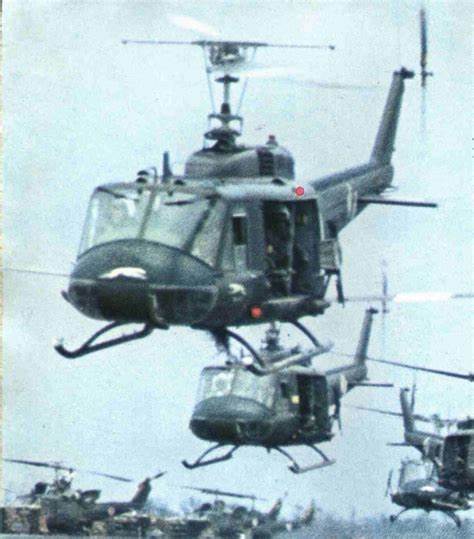
The 240th Greyhounds…….We could go into a Pickup Zone or Landing Zone, not knowing what was there but ready to do our jobs. That’s brave. We could take fire From the Viet Cong or North Vietnamese Soldiers and shoot back with adrenaline flowing, that’s courageous. We could go into the firestorm of bullets and attempt to rescue our fellow soldiers, now that was absolutely daring.
We were everything that can be said about helicopter crews and more. Did we ask for it? Yes, we all volunteered for it. Did we expect any praise, no….we wanted it though if just for us…so we could feel needed…. feel like somebody special… But most of all we wanted it from our fellow crew members, and we got it tenfold. We channeled each and every move we made for us and our guys, our unit…..our brothers……in Vietnam we knew we only needed each other to survive…. All of us have a special bond.
No one will ever understand, except us. Not the world, not the civilians of the world. This is why these reunions are so important to us. Be proud of what you did guys, we were all these things. Everyone of You out there…..we were all Brave, Courageous and Daring…….you Know….. It’s great to be humble…. but all you relatives out there, these guys were heroes…the real deal….and always will be.
Guys, we can go back to eating humble pie when we leave Branson……but today, and during this reunion, we will relish who we were……. What we did……. Who we helped…….and who we saved. We were Brave, Courageous, and Daring………Flying through the skies of hell and back, all this from a base in Vietnam called Bearcat.
Be proud,……..you were the backbone and workhorse of the Vietnam War. Now…….going Back to my fearful water jump. I had fear as I looked in that water, I still do…but I am old now….but,…..I am so glad that when I look back on Vietnam I can be happy in knowing I could harness that fear like all of you did and do those Brave, Courageous, and Daring things that made us Greyhounds and MadDogs, and Kennel Keepers.
In wrapping up…. Friends……and Relatives out there, When these guys step on some dock and don’t jump in the water, just remember the days when they did even more dangerous things and didn’t bat an eye. When one of our guys was wounded which totaled several hundred guys during our 240th existence, we got mad and our hearts were wounded…… When one of our 38 who were killed, POW or MIA, ……… a part of us was lost forever on the battlefield, …..never to return.
Through it all we grieved, cried, cursed……in the end, they were still gone. We picked ourselves up and continued on, doing what we loved doing. Flying….yes but most of all still being Brave, ….Courageous ….and Daring …..in a helicopter called Huey.
Be proud of being a Greyhound, Maddog, and Kennel Keeper. We were………. and always will be the best to have ever flown……no questions about it….You, my fellow brothers, have earned it, and you deserve it.
F I N A L E… To my forever brothers in arms, the 240th Assault Helicopter Company…I salute you…….GO GREYHOUNDS!!! And leave the Flying to us…….

Richard Toops contributed an earlier article to this website recalling one of his missions when his ship was shot down. Click on the link below to be redirected. Use the back arrow key to return to this page.
https://cherrieswriter.com/2020/04/26/the-incident/
*****
Thank you for taking the time to read this. Should you have a question or comment about this article, then scroll down to the comment section below to leave your response.
If you want to learn more about the Vietnam War and its Warriors, then subscribe to this blog and get notified by email or your feed reader every time a new story, picture, video and changes occur on this website – the button is located at the top right of this page.
I’ve also created a poll to help identify my website audience – before leaving, can you please click HERE and choose the one item that best describes you. Thank you in advance!
My book, 2-27-70, was selected as the 2023 Grand Prize Winner competing against many great authors and their books. Check this out!
October 28, 2023
Hamburger Hill – The Last Patrol
My friend, Jonas Thorsell, re-discovered the battlefields of Hamburger Hill with some Rakkasan warriors who fought there 54 years ago. Join them on their quest to reach the summit.
As I sit down and write this, it is almost exactly 11 years since my first visit to Hamburger Hill in the A Shau Valley in the western mountainous area of Vietnam.
I was on a motorbike trip with a friend, driving around the northern parts of what once was the I Corps area. We had come down the valley from a visit to Khe Sanh and got ourselves a hotel room in the small town of A Luoi. As I knew there was a requirement for a permit from the police to visit Hamburger Hill, I asked the hotel manager if she could make some phone calls and help us arrange for a permit. She said it was probably too difficult as they normally need a few days to do that. Nothing is impossible in Vietnam though and she managed to get it done. We paid the fee and arranged a time with the guide that was going to take us there.
Morning arrived and we made an early departure from the hotel with our guide. Driving west across the valley, it was very foggy and rainy, and we were already starting to get cold. After having delivered our papers to the police office in the little village near the mountain, we started the ascent with our trusty motorbikes. As we reached the end of the small road, we parked our bikes and started the long walk up the mountain. Even for reasonably fit forty-something guys, it is a grueling climb. As you get up the mountain, they have erected a monument with inscriptions containing a propaganda message, there is also a small shrine at which you can light some incense and pray for the lost souls.

Many tour guides will stop here and tell their guests this is the summit of Hamburger Hill. It isn’t. It isn’t even Hill 937, this is the area around Hill 900 where another Airborne unit fought during the battle and struggled against a well-dug-in enemy. Hill 937 is another 500 or 600 meters north along a trail. Getting to Hill 937 isn’t very difficult from here. It’s a ten-minute hike and as you reach the 937 the jungle is gone and the area is covered with tall grass, often called Elephant Grass. There is a sign declaring that this is the A’ Bia airport, I have never really understood why they call it an airport, maybe because US forces would
land choppers there after the battle and the hill was manned with fresh troops over the next few weeks.
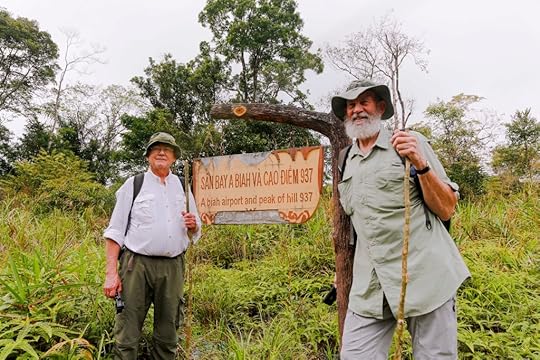
The Battle
The battle of Hamburger Hill was fought from May 10th until May 20th in 1969. The operation included that Airborne units were to land north and south of the Doi A Bia, or Hill 937, and patrol the area in search for NVA units that they were supposed to drive back across the border to Laos. In fact, the first unit that landed on a ridge north of Hill 937 started to patrol west towards Laos to set up a position near the border river. This was Alpha Company 3/187th of the 101st Airborne Division, led by Captain Harkins. Only later in the day did Lt. Col. Honeycutt start to send units along the ridges south towards Hill 937.
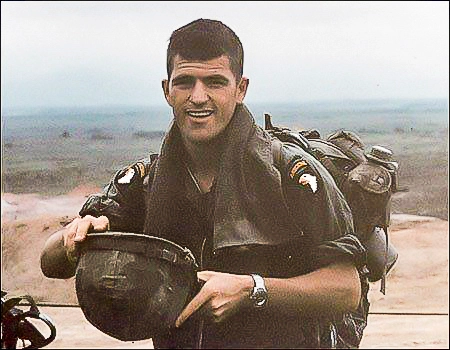
As The Rakkasans advanced along the ridges, they started to meet heavy resistance, so the battle had started and it would be another ten days before they had taken the summit. Even in the following days after that, people continued to be killed as NVA had snipers on and around the mountain that would harass the Airborne forces.
A Journey in History
In 2015 I encountered Frank Boccia in a Vietnam War history group online. Frank had been the Platoon Leader of 1st Platoon, Bravo Company in the 3/187th during the battle and had written a book about his experiences during the war and particularly the battle. The book is called “The Crouching Beast: A United States Army Lieutenant’s Account of the Battle for Hamburger Hill, May 1969”. As Frank found out that I had visited the hill, we started to exchange photos and information. Frank had also traveled back to the hill in 2006 as he was in an episode of “War Stories” with Oliver North. Frank shared with me his notes about locations on the hill and the work he had done with Dan Bresnahan, who was a Platoon Leader in Alpha Company during the battle, to correct the After-Action report that is alarmingly fraught with errors.

We became online friends and decided to arrange to meet up in the coming years to discuss the history of the battle and the real locations further. Unfortunately, before we got the chance to meet, Frank passed away in June 2016. I was of course saddened and stayed in touch with his widow.
My history work in Vietnam continued, I did work with and for a friend in a 1st Cavalry Division unit who had fought in I Corps during the Tet offensive in 1968. I kept visiting and documenting war sites in combination with making the history of those places known on my website https://namwartravel.com/
2019 Return to Hamburger Hill
In 2018 I was contacted by Mike Smith, a decorated veteran of the battle and a board member of The National Rakkasan Association. He told me they were preparing for the upcoming 50th Anniversary the following year and that they also planned to bring a group with veterans and active soldiers to the hill after the reunion in May. Mike had heard that I had visited the hill and thought I could have some input.
As I had the information from Frank Boccia on the actual locations of the battle and I also had a trip back to Vietnam planned in February 2019, I quickly decided to re-arrange my travel plans so I could include a visit to the hill. Mike and I kept our discussion going and an idea about making a video about the battle began to grow. With a combination of modern-day video footage from the battlefield, wartime pictures, and recorded audio of Cpt. Harkins and Dennis Helms sharing their stories from the battle, the video was highly appreciated by many veterans and family members.
Video Link Return to Hamburger Hill:
https://youtu.be/5jy8MByDBwA?si=xmXRwzBCVSNrCCAw
This was the first time I ventured beyond the summit of the hill. We located the northern and western approaches to the summit hidden in the jungle and went down both. From what at the end of the battle was a moon landscape, the jungle had now re-taken it and was thick and lush. We could follow trails that the locals use, and I managed to pinpoint a few locations of interest.
After the February journey, I handed over my information to Mike and they made their final preparations for their return. For the veterans, it was their first visit back to the place where they had fought 50 years ago. For the active soldiers, it was a journey into a history they had only heard and read about.
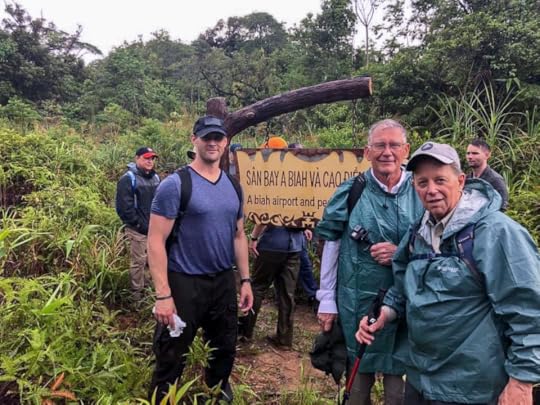
Arriving at the hill, the large group started to make the ascent. Some of the veterans needed assistance from the younger soldiers, but in the end, all got up to the monument and a smaller group ventured all the way over to the summit. Once again, The Rakkasans conquered the summit of Hill 937.
The 2022 Hamburger Hill Reunion
In 2022 I was invited to attend the Hamburger Hill reunion in Clarksville TN. and Fort Campbell KY. It was of course an amazing experience to meet all these men I knew via social media and many of them I had only read about so I only knew them by name through Boccia’s book and other sources. What I witnessed was a group of men sharing the experience of serving in Vietnam more than 50 years ago and taking part in one of the most famous battles of the last century. There were tears and laughter and the bond between these men was very strong. I was fortunate to get the chance to sit down with a few of them to record video interviews. The week of the reunion has a full schedule, but there is enough space in it for people to hang out together and talk about old memories.
Between the planned ceremonies, a day at the shooting range, briefing sessions, and dinners in the evenings, it was a week that I will never forget. It also became clear to me that this group of men is held in very high regard at Fort Campbell and within the 101st Airborne Division.

The Last Patrol
A couple of months later, as I was still digesting the experience of attending the reunion, Mike contacted me about going back to the hill together. We had talked about it before, but I wasn’t sure if we could make it happen. As it turned out, John Snyder from 1st Platoon Bravo Company had decided he wanted to join us as well. So after having detailed our plans, I also asked my friends and colleagues in the namwartravel team, Stephen Berlinguette and Ciarán McCann if they would like to join. Both immediately agreed and started to clear their schedules for that week in February. Now we were a team of five.
We made plans to stay overnight in A Luoi in the A Shau Valley about 40 miles west of the city of Hue near the Laotian border. After an early morning check out from the hotel in Hue, we boarded the rented van that would take us up to the valley. On the way, we stopped at the site of LZ Blaze from where the Rakkasans had lifted off on their combat assault to Hill 937 that morning almost 54 years ago. After the stop we continued to the hill, stopping on the way to drop off our papers at the police office and picking up two additional local guides from the village. I had asked our regular guide Mr Vu to arrange for two more guys from the village that could help carry our load and hopefully also provide some local knowledge of the hill. And they sure did. They knew every inch of the hill, having spent their lives going up and down Hill 937 and the surrounding hills.
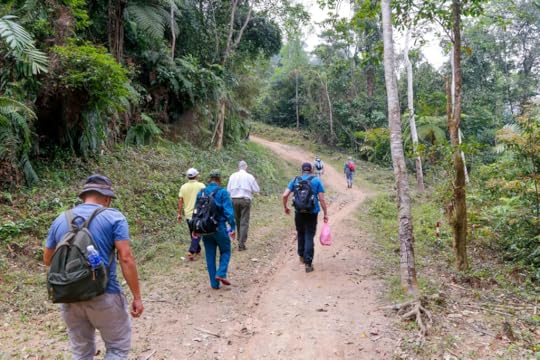
It took us a good hour or so to get up to the monument. We stopped there for a quick snack before we continued towards the summit. On the summit, they had cut down the elephant grass which made it quite easy to navigate and move around. We stopped by the sign, took some pictures and Mike and John shared some stories with us.
We had chosen to move down the ridgeline where both Mike and John had fought during the battle. John with Bravo Company had fought here the first six days of the battle before they were pulled back to the Battalion CP and Mike’s Delta Company came in to take over their positions.
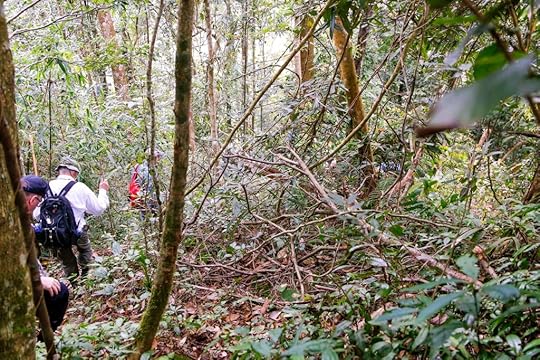
It is a very steep descent from the summit on the northern side. At some points you slide down the steepest bits, hoping you won’t fall over and tumble all the way down. A couple of hundred meters down from the summit, we were in the area that Boccia calls The Clearing in his book. This is where Bravo Company got stopped during every assault the first days. The NVA had a .51 caliber machine gun trained directly on the entry point to that section and there was nowhere to get around it considering the steep slopes on either side of the ridge. They had to face the brutal and deadly fire from the enemy as they tried to flank the enemy bunkers, only to be pushed back by heavy machine gun and RPG fire. Unfortunately, they also fell victim to friendly fire from both the jets dropping bombs and Huey gunships shooting ARA.
On the 18th, the ninth day of the battle, Mike in the 2nd Platoon Delta Company reinforced by a small unit from the battered Charlie Company was pushing up this section, at the time, the jungle was gone. Trees stumps, logs, rocks, and craters were the main features. And mud. As the battle raged, the rain came in heavy, turning the steep slope into a muddy hell. The Airborne soldiers crawled up as they advanced towards the NVA soldiers shooting down on them. Delta took heavy casualties, including having their Company Commander seriously wounded. One of the Charlie Company Platoon leaders was left for dead, but he managed to crawl back down to safety.
It would take two more days of intense fighting before The Rakkasans could finally take the hill.
Walking down this area with two of the men who had fought, and lost friends here was a very powerful experience. None of us non-veterans really knew how to relate to this, so we all tried to focus on the terrain and moving forward. I tried to guide Mike and John to the best of my knowledge on the specific terrain features that they would know so they could match it against their memories of the battle.

We spent several hours on the mountain that day and got as far down as the area where they had their Company CP set up. Navigating in the thick jungle isn’t always the easiest thing to do, but with some solid navigating, we knew we were in the right place. There were even some marks of the old foxholes that the soldiers had dug in the area. Around the area, we also found a poncho and some rubber holders for radio batteries.

Realizing we would run out of daylight; we started the climb back up the steep hill. After several hours on the mountain, we could all feel the strain, so we made sure to move slowly but steadily.
As we were leaving the battle area, Mr Vu asked Mike; is this the last patrol? Mike replied it probably was. I found it fitting so I have decided to name the video series I am working on, Hamburger Hill – The Last Patrol. Below is the first part where I sit down with men from 1st Platoon, Bravo Company, including John Snyder who was with us on Hamburger Hill this time.
Video Link The Last Patrol:
https://youtu.be/_yQ1PF7lX48?si=c0hEHR1nYUKTxg8h
Traveling there with these legendary warriors was a humbling experience. I learned so much from Mike and John as we explored the area. Not only about the events and locations as such but also the impact the battle had on these men and their brothers. Mike told me afterward he had found some closure.
I hope you have enjoyed reading the article together with watching the images and the videos. My aim is to help veterans tell their stories and I hope people will learn more about the war and what these men went through. This amazing journey was probably a once-in-a-lifetime experience. But my project doesn’t end here. I already have my next visit to the hill planned and there is much more to explore there. Among other things, I want to reach all the way back to the Battalion CP and the original LZ area. I will continue to collect material about the Hamburger Hill battle and other events during the war and hopefully help more people understand better what these brave men went through.
If you want to learn more about our work, then check out the https://namwartravel.com/ website. Feel free to contact me at namwartravel@gmail.com. I am happy to answer questions and share my material. I would also like to convey my deepest gratitude to John Podlaski for letting me write this little piece for his excellent website.
*****
Thank you for taking the time to read this. Should you have a question or comment about this article, then scroll down to the comment section below to leave your response.
If you want to learn more about the Vietnam War and its Warriors, then subscribe to this blog and get notified by email or your feed reader every time a new story, picture, video and changes occur on this website – the button is located at the top right of this page.
I’ve also created a poll to help identify my website audience – before leaving, can you please click HERE and choose the one item that best describes you. Thank you in advance!




